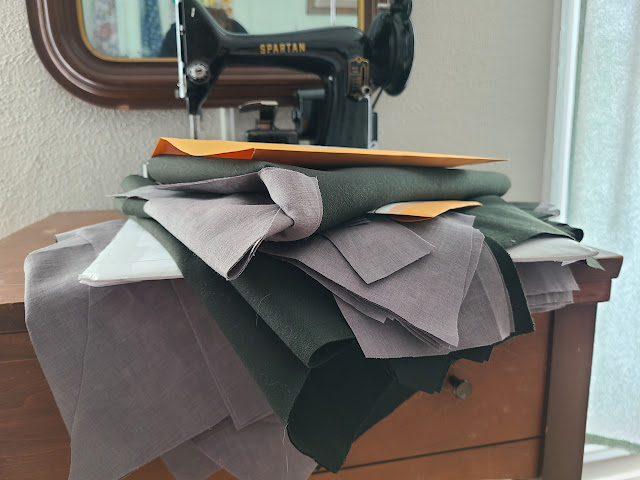A Ditto Suit: Or, The Latest Challenge
 |
| John Redhead by George Romney, 1780 |
After the success of my most ambitious project to date, the round gown from Fitting and Proper, I yearned for the next challenge in 18th century costuming. I do have a francaise in mind, but the time still hasn't felt right to execute that. Until I have a formal event to wear it to, the francaise will wait. I already realized that I went from zero 18th century gowns in 2022 to three in 2023, and I don't want to extend my 1930s evening gown problem to another century (i.e.: I have more evening gowns than have ever gone to formal events).
As I remarked in my post about the shirt, when I hear a thing is difficult, I often find that a call to arms. With my confidence in drafting boosted by the round gown, I began to formulate ideas and draw inspiration. As with women's wear, my interest does not lie in the elaborate and formal with its brightly colored silk and intricate embroidery. I admire that work, but my taste has never run to those things. I prefer rich, dark color and details in the construction. The ditto suits, such as those pictured above and below, drew me the most.
 |
| Suit, probably British, 1770-1780, the Met |
The suit above has a more pronounced standing collar than some others, which I like, but I found the frock coats, with their tall stand-and-fall collars the most appealing to me. I've always liked a collar, and most of my wardrobe reflects that. Over the holiday break, I spent time pouring over books, images, and blogs to glean all the knowledge I could. The suit from Costume Close-Up was referenced by many, as well as items in Norah Waugh's The Cut of Men's Clothes (as a note, this out-of-print resource can be found online as a pdf). For breeches, waistcoats, and suits, there was no shortage of patterns, guides, and charts. The frock coat proved itself a little more difficult. In one excellent Facebook group, many people discussed patterning their own frock coats, but with my relative inexperience with the 18th century in general and menswear in particular, that seemed like a recipe for disaster. After diving deep, I discovered many people discussing the Henry Cooke frock coat pattern. All the threads I followed took me to workshops and classes, no books or patterns. Finally, when my eyes felt like they'd fall out of my head, I found that Wm Booth, Draper carried it under the brand of "Historical Costume Services." After drafting my last piece, purchasing a pattern felt like a bit of a cheat. However, I knew it would 1. lead to a far more successful outcome and allow me to learn, and 2. I would have to make more than a few modifications for size and fit anyway. I had my plan.
Thanks to a wondrous wealth of Christmas gifts, I also had most of my materials. My parents got me two full bolts of muslin, which would be put to work for drafting, and my husband got me a gift card to Burnley & Trowbridge. I had been keeping an eye on a beautiful dark green worsted from them, and the gift card was exactly enough to get what I needed. The "Charleston green" color is a cozy and pleasing shade, and the weight of the wool is perfect. Buttonhole twist and black linen thread were also purchased for the making of the suit. My goal was to make frock coat and breeches to match. If I had enough for a waistcoat, so much the better, but I have ideas for a contrast waistcoat that I think would look quite nice as well.
 |
| A project preliminary grouping |
After I got all of my pattern pieces drafted and fabric cut, I had more than enough yardage for a full ditto suit after all. Yardages aren't given for most of these gridded patterns, and most online sources said 7 yards of fabric would be needed for breeches and frock coat. The problem was that these estimated amounts were for suits for grown men with a chest measurement of 38 or 40 inches. I am a small woman with a 34 chest. I still went with 6 yards of fabric for all three pieces to be careful, and ended up with nearly enough left over to make a second suit. While it seems like a bit of a waste to me to have that much left over from a planned project yardage (I've always needed to be something of a frugal sewist and typically only buy what I need for a project), this amount of surplus means that I don't need to panic if something goes horribly wrong and I need to re-cut any pieces. Even the largest pieces will fit in the yardage I have left over without the need to do any piecing. After the piecing I needed to do on my round gown, it did take a bit of the pressure off. And if I didn't need to re-cut, so much the better--2.5 yards of wool stuff is more than enough to make something else nice, whether it be for my 18th century wardrobe or my everyday vintage one.
From this point forward, I will be documenting my progress by the garment: a post on the frock coat, a post on the breeches, and a post on the waistcoat. The final reveal and overall notes will be in their own post as well. I don't have a timeline, as this project is one I plan to take my time on within the limits of my schedule and my budget. Wish me luck!
 |
| 79 pieces of fabric ready to become a 1770s ditto suit. |


Comments
Post a Comment